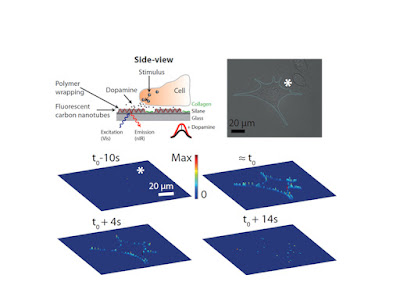Chemical signalling between biological cells is the very essence of life, but it is difficult to measure such signals using existing techniques – such as those that rely on microfabricated electrodes, for example. A team of researchers from the Massachusetts Institute of Technology (MIT) have now succeeded in imaging how the neurotransmitter dopamine is released from a single cell using an array of 20,000 individually addressable sensors. The spatiotemporal resolution of the new technique is several orders of magnitude larger than that of previously reported electrode-based approaches.
Cells communicate with each other using waves of chemical concentrations that change in both direction and time. However, unlike electrical potentials, measuring this chemical signalling between cells and within cellular networks is more difficult – and especially at the spatial resolutions required to find out exactly from where on a cell chemicals are released.
Michael Strano and colleagues have now taken an important step forward to overcoming this problem. The researchers have developed fluorescent nanosensors based on single carbon nanotubes that can be placed under and around neuroprogenitor cells and image how the neurotransmitter dopamine is released from these cells. Thanks to their small size, as many as 20,000 sensors can be placed around an individual cell.
SWCNTs fluoresce brightly in the presence of dopamine
“The nanosensor array is composed of single-walled carbon nanotubes (SWCNTs) deposited on a microscope slide,” explains team member Daniel Salem. “These nanotubes fluoresce in the near-infrared (nIR) part of the electromagnetic spectrum when they are excited with laser light and we wrap them in single-stranded DNA to make them fluoresce brightly in the presence of dopamine.
“By imaging the surface beneath a cell with these sensors and making a movie of the nIR fluorescence, we are able to observe turn-on responses of individual pixels and correlate these with dopamine release from the cell.”
SWCNTs are versatile building blocks for biosensors, he says, and can detect down to the single-molecule level. The researchers chose to study dopamine in their work because it plays a central role in reward control and learning in humans.
Nanotechweb: Nanotube array images neurotransmitter signals, Belle Dumé

Comments